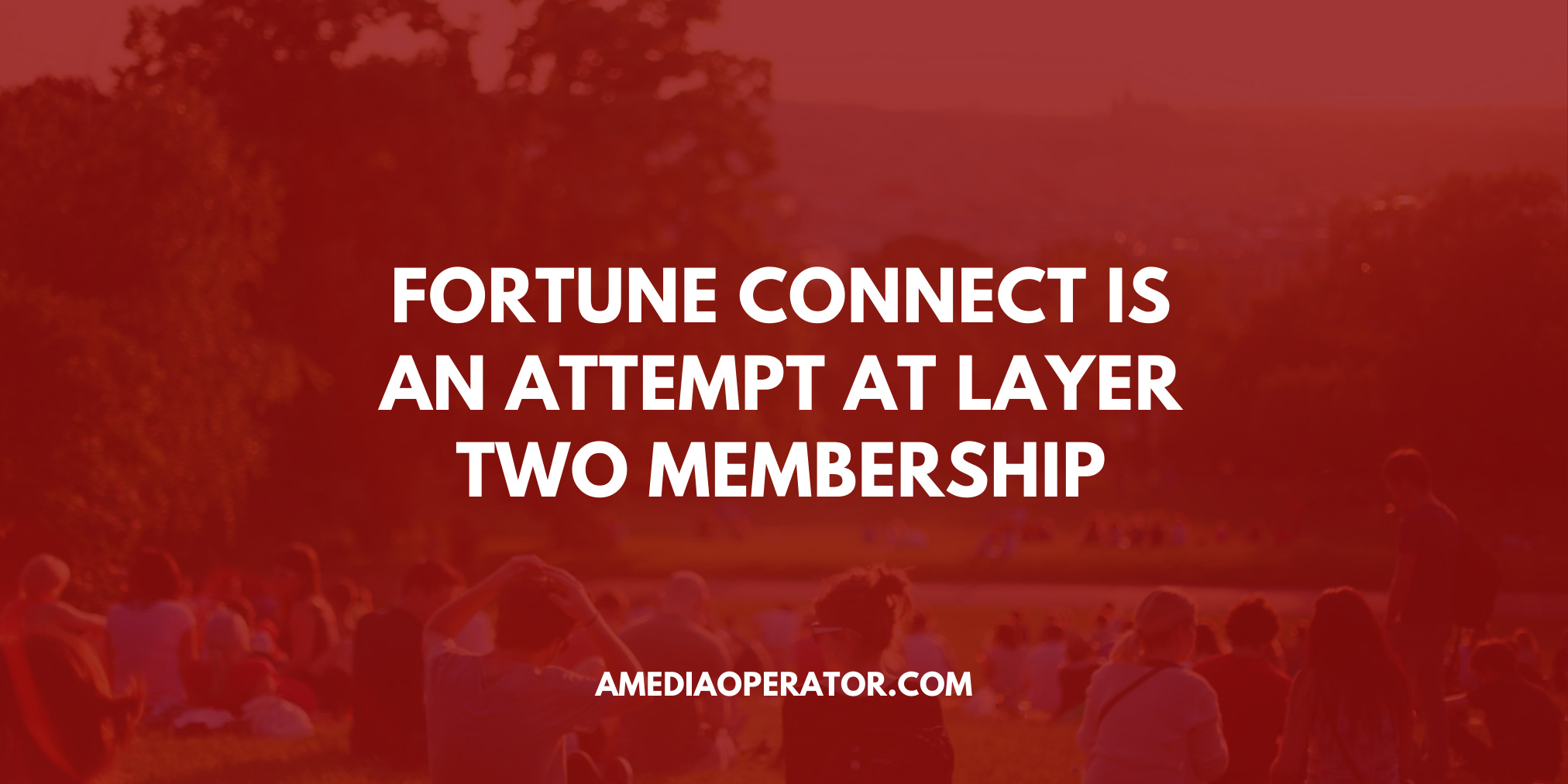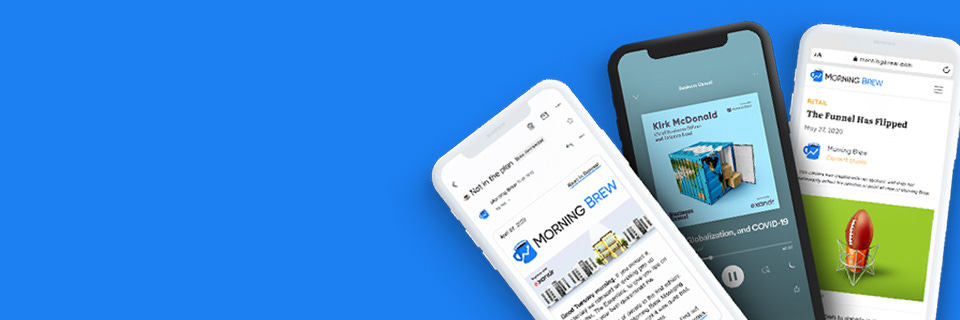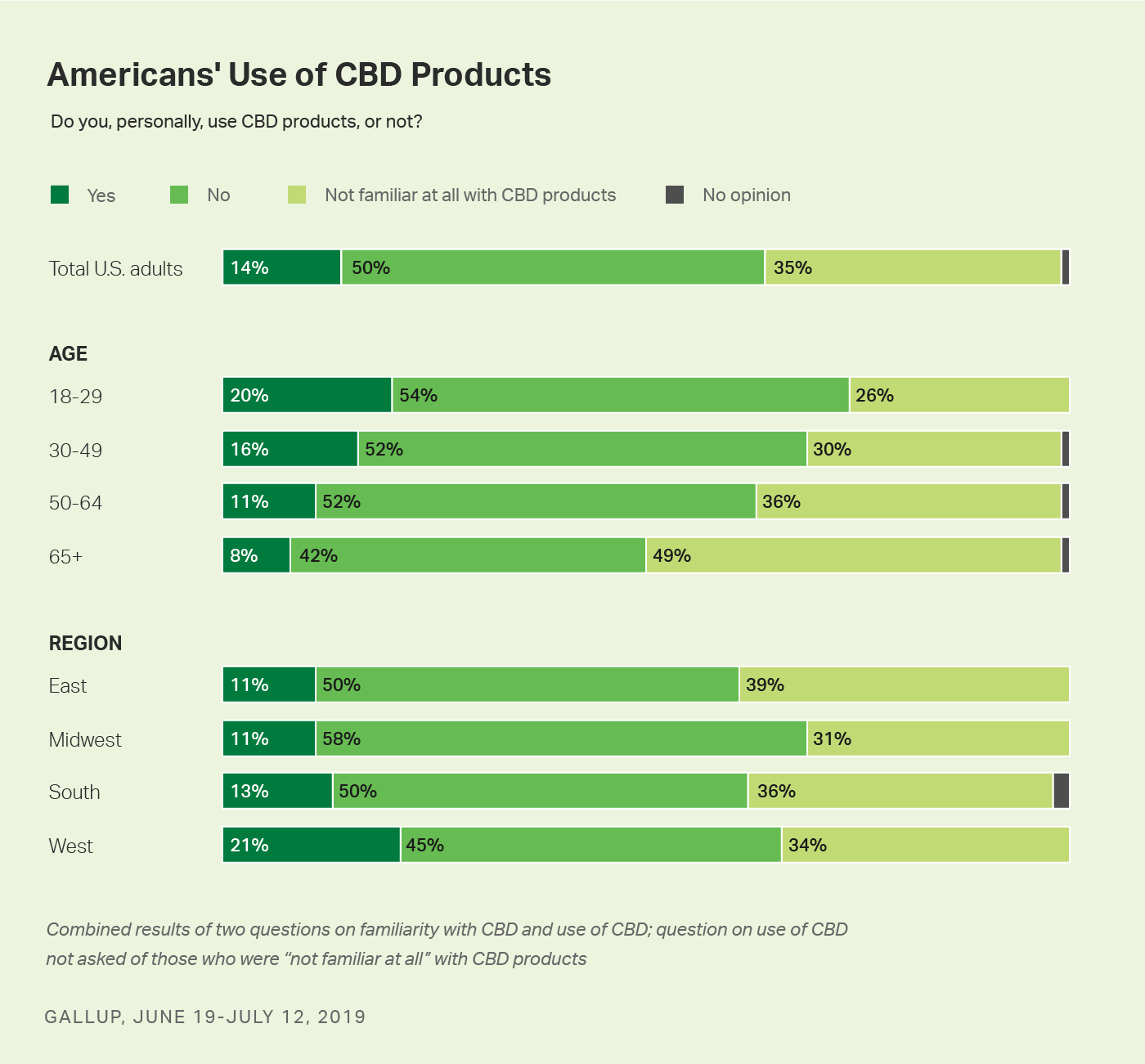 |
With events sidetracked for the foreseeable future, media companies are having to get more creative with how they engage with their audiences and generate revenue.
To that end, Fortune announced that it was releasing a new product called Fortune Connect, which is for people that are not in the C-suite. In the announcement:
Fortune Connect is designed to help the next generation of top leaders prepare for this change. We provide weekly programming aimed at allowing Fortune Connect fellows to interact with the leaders at the frontiers of business change, with a special focus on purpose-driven business, stakeholder capitalism and inclusive leadership.
Connect costs $2,500 per person and the offering is relatively straight forward. According to Digiday:
To start, there will be an online library of repurposed recorded conference content and a weekly newsletter. And a few weeks into October, virtual meet-ups, participatory events and “sprints,” or condensed lessons of important topics, will kick off as well, McGirt said.
It’s “a scalable platform for providing the lessons that we give at our conferences to a much broader group of executives,” said Fortune CEO Alan Murray, adding that CEOs who attended conferences reported to Murray’s team that the information presented would benefit emerging leaders in their companies who weren’t at the high enough level to attend the conferences themselves.
An extension of the conference business, Murray said that Connect will link conferences to the digital reader revenue business that the company recently began to cultivate last year with the launch of its three-tiered paywall.
What I like is that I can see signs of something I wrote about a few weeks ago:
The first is the access layer. As a writer with paying members, you have access to me. Many of you reply to my essays and share your thoughts. I get on calls with you, we discuss random topics and it’s a great thing.
…
The second layer is the network layer. This layer is what you think about when you think of super popular internet forums or twitter threads that just continue splintering as new people pop up with their own perspectives.
With layer two, the point is for people to feel as if they have access to each other. You have less control over this other than providing the format by which the community forms. Whether that’s forums, Facebook groups or Slack channels, your control only goes so far.
Let’s break this down a little because it really is a straightforward way to build a membership product.
At its core, Fortune is using its content as the nucleus; this is fundamental to any good membership. In this case, it’s the repurposed recorded conference content. By taking previously used content and repackaging it, Fortune can deliver on its narrative without needing to create a ton of upfront content.
The first layer is all about these new members having exposure to people at Fortune and the publisher’s partners. This is important because it builds a deeper loyalty between Fortune and its readers and provides a channel for product communication.
However, the real magic happens as Fortune expands into the second layer. Here are a few of the opportunities listed on the Fortune Connect website:
Fortune University: In small groups, learn the latest trends and strategies from experts and researchers.
Deepen your connection to the Fortune Connect community via networking and happy hour events.
Share new information and work collectively with your peer group to refine your ideas.
Each of these are Fortune providing the platform, but the actual engagement is between the members. This network layer is where real stickiness takes place. There are two benefits that are closely related.
First, the ability to meet other people and learn from different industries is a good reason to sign up to begin with. Second, you don’t want to leave because then you might miss out on future connections. Because this is an open-ended membership, a single person could, theoretically, spend years subscribed.
But it’s not going to be an easy exercise. While layer two is reader to reader, the publisher still needs to ensure that the right conversations are happening. If anyone has ever run a forum before, the worst thing is when nothing is being discussed. Fortune will need to make sure that people are seeking the community out; otherwise, the two above benefits will no longer exist.
Suffice it to say, there is a lot to like about this offering. For Fortune, it acts as a feeder program for Fortune’s other executive-level products. This is what the funnel looks like:
At the top, a subscription to Fortune. This costs $200 a year (if that) and gets you access to the content.
In the middle, a membership to Fortune Connect. For many people, this might be the bottom of the funnel, but for some, it’s the middle, because…
At the bottom, $15,000 executive conferences specifically for those in the C-suite.
This presents a great opportunity for Fortune to monetize across various levels of the funnel while ensuring that the right people are in the right product. That’s all a publisher can ask for.
Sponsor
 |
Join Morning Brew’s Team
Everyone who reads A Media Operator knows that I’ve got a soft spot for newsletter operators. I think the direct push into a reader’s inbox is the best way to build a long-term relationship.
Morning Brew agrees. And Morning Brew has seriously perfected that art, growing to over 2,000,000 subscribers across four newsletters with fans that rave about them. With that growth comes a need to bring on incredibly talented people. So, they turned to the AMO community because obviously we’re the most talented.
Here are some of the roles they’re looking to fill:
GM of B2B Media: Talk about my dream job… Morning Brew has three business verticals—Emerging Tech, Marketing and Retail—and they need an operator to help take them to the next level. You’ll get to own the B2B business.
VP, Head of Product: Content at Morning Brew has historically been the main product. But that content needs a variety of delivery formats. The VP, Head of Product will be responsible for owning that and the coming paid product.
Head of Multimedia: Morning Brew may have started as a text-based newsletter, but the ambitions are to become a cross-platform, multimedia company. They need someone to lead that charge across podcasts and video.
These are just three of the two dozen roles open at Morning Brew. Want to join a profitable and rapidly growing media company that is doing a lot of really interesting work? Apply today.
Should publishers deal with CBD?
There’s an interesting discussion to be had around CBD products and publisher’s commerce businesses. In a story on Digiday:
Yet few mainstream publishers have managed to turn CBD into a big hit for their commerce businesses, thanks to a combination of regulatory uncertainty, a glut of product, and a hesitancy among publishers to forcefully endorse products that some people — and some doctors — still regard with skepticism.
“I have no question in my mind that it would drive a substantial amount of commerce revenue [if we recommended things indiscriminately],” said Kate Spies, svp and gm at Leaf Group, which operates the health and lifestyle media brands Well + Good and Livestrong. “But we try to err on the side of facts and science. Unless we have a dermatologist, a doctor, an expert co-sign that product, we don’t cover it.”
The problem for publishers is that CBD products have grown into a $9.3 billion business in 2020 and will be more than double that size in five years. It’s hard to look at that potential revenue—Digiday reports commissions could be 20-40%—and just not take advantage of it.
And yet, there are very few publishers that entertain it. But should we be looking at it for new revenue opportunities?
The answer, ultimately, boils down to the publications’s audience. According to a Gallup poll conducted in August 2019:
Although CBD was legalized federally last December, the FDA is still researching it, and some states are still restricting it. While 14% of U.S. adults are using CBD products, Gallup's June 19-July 12 polling found that 50% do not use them and 35% are not at all familiar with them. (Those who do not have any familiarity with CBD products were not asked about their personal usage of them.)
The full findings can be seen in this graphic:
 |
A few things jump out to me on this chart worth analyzing.
First, there’s a clear age disparity. The younger the audience is, the more likely they are to be both informed on what CBD products are and to use them.
Second, there’s a geographic disparity across the country. In the west coast, 21% of people use them whereas the rest of the country is in the low teens.
What this tells us is that if your audience is younger and lives on the west coast, it’s more likely they are CBD product users. This would make a regional publication more likely to benefit from this sort of a commercial opportunity.
My stance on this is pretty straight forward… Follow what your users are engaging with. If you have written about these sorts of products in the past and you see it being overwhelmingly engaged with, you might be onto something.
Even if you’re not ready to start promoting these types of products, do the necessary research to make sure your company is informed. There is opportunity here and we should be ready to start taking advantage of it when the regulatory and educational requirements become clearer.
Early fall out from Facebook banning Australian news?
In the beginning of the month, Facebook warned that it would begin blocking users in Australia from sharing news on its platform.
This was in reaction to the Australian Competition and Consumer Commission working on a bill it says is meant to save Australian media. Essentially, it stipulates that publishers and platforms have to negotiate on a deal that would have platforms pay for publisher’s content distributed across their platforms.
In other words, Australia wants the platforms to pay publishers for the right to send traffic to those same publishers.
Splice published a good story that explains who is ultimately going to lose with this new regulation:
The expectation that Facebook’s definition of “news” will be drawn widely to avoid any legal fallout has created panic at digital-only newsrooms.
In particular, lifestyle and youth publishers that source the majority of their traffic from Facebook face closure, while traditional media players who campaigned for the laws look set to be the relative winners in a “scorched earth” media environment post-regulation.
Essentially, if Facebook and Google pull out, the major brands will be able to survive. However, those younger publishers that have not had time to build a strong brand and depend on platforms will be left without a major audience channel.
This sort of outcome is to be expected, though. Regulation doesn’t often hurt the big players—platforms or major publishers. Instead, it becomes an unbearable burden on the smaller players—these digital first publishers.
Now, look… This doesn’t mean that these digital publications are without fault. Being dependent on anyone for all your traffic is dangerous. These younger publications need to learn how to convert Facebook’s traffic into an owned audience. And I hope that they do.
I understand that governments want to find ways to save media. I’m not going to say that’s a bad thing.
But any regulation needs to be grounded in logic, not emotion. These sorts of bills are created to benefit major players. No one thinks that News Corp or Nine (the major players in Australia) are going to suffer from this. The amount of money that will trickle down to smaller publications is likely not even worth it; but the audience is definitely is.
If we believe that these platforms owe a responsibility to support media companies, then governments should take a simpler approach and just tax them. Governments can then provide tax breaks to media companies that serve a civic responsibility. At least this way, more media companies can benefit from it.
But as I’ve said many times before, making platforms pay for the right to send publishers traffic is illogical.
Thanks for reading today’s newsletter. If you know anyone that would like to read A Media Operator, consider sharing it. And if you’d like to receive my Friday essays, become a premium member today.

